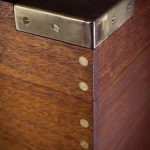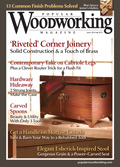We may receive a commission when you use our affiliate links. However, this does not impact our recommendations.
 This strong and simple – but uncommon – joint imparts a decorative touch.
This strong and simple – but uncommon – joint imparts a decorative touch.
by Christopher Schwarz
pages 22-25
After 20 years of making furniture, it’s not every day that you stumble on a joint you’ve never seen before. But that’s exactly what happened several years ago when I encountered a floor chest from the West Indies in a Charleston, S.C., antiques store.
The chest had a series of brass circles that ran in a line up each corner of the chest. At first it looked like brass inlay, which is a common feature of some Anglo-Indian campaign furniture pieces I’ve encountered in my research.
Instead of decoration, however, the brass circles turned out to be the joinery.
The dealer, who had imported campaign furniture from the Indies for decades, told me that some collectors referred to that joint as a “rivet.” He explained that the rivet was nothing more than a brass screw that had been driven in so its head was still proud. Then the screw head was filed flush to the carcase, eliminating the slot.
It’s a surprisingly simple and (I think) attractive way to make a strong joint that looks a lot better than having 12 wooden screw plugs lined up on each corner.
This approach shows up in other applications in the woodworking field. Sometimes, screw heads are filed flush with a piece of hardware. And if you’ve ever seen an infill handplane, you know it is common for the maker to screw in both the wooden infills and the lever cap inside the shell then file off the heads – making for a clean sidewall of the tool.
After attempting the joint on several pieces of scrap, I decided to use it on a campaign-style trunk that features a lot of brass hardware. Making the “rivets” didn’t require any new tools – just a simple jig made from two scraps of wood.
Here’s how I did it.
Web site: Read more about building campaign furniture.
Blog: The author has reviewed lots of campaign hardware – read about it on his blog.
Web site: Visit a leading dealer of campaign furniture.
In our store: Build a Roorkhee chair, in the October 2012 issue of Popular Woodworking Magazine.
From the June 2014 issue, #211
Here are some supplies and tools we find essential in our everyday work around the shop. We may receive a commission from sales referred by our links; however, we have carefully selected these products for their usefulness and quality.








